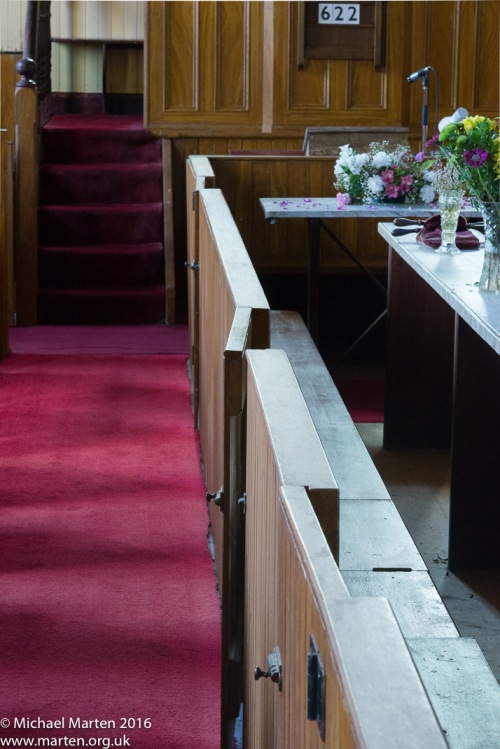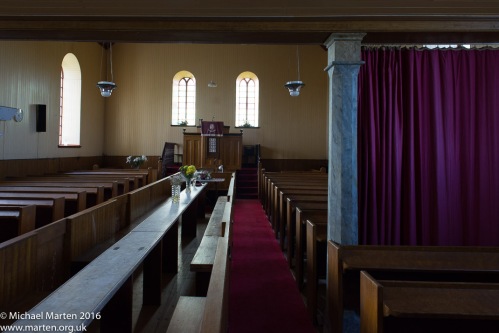The Church of Scotland and related Presbyterian churches in Scotland have only two sacraments: Baptism and Communion (in other traditions, called the Eucharist, Lord’s Supper, Mass, Divine Service etc.). As with many traditions, the interpretation and practice underpinning these sacraments has changed significantly over time (a very gentle way of hinting at huge controversies that have dominated Western ecclesiastical history for centuries!).
One of the key disputes in Presbyterian tradition has been over who is allowed to receive the elements of bread and wine at the Communion Table (as it tends to be called in Presbyterian contexts). There are several understandings, which can be summarised as follows:
- open – it is understood to be the Lord’s Table, and not that of any one church, and therefore nobody may be excluded who regards themselves as Christian. Phrases such as “All who know the Lord” are often used in the invitation. Doctrinally, the contemporary Church of Scotland follows an open pattern, though this is a relatively recent development.
- guarded or close – only those who have been baptised and are members of a recognised church may participate in Communion. This can exclude children, for example, who might not be regarded as full members of a church.
- closed – only members of that particular church are admitted to Communion. The Catholic Church theoretically operates on a closed basis: doctrinally, only Catholics are supposed to receive the elements, though in practice I have often been invited to join at Mass, even though the priest knew I was not Catholic.
This third category is of interest to me here. In Scottish Presbyterianism, particularly in the 18th and 19th centuries, adherence to closed Communion led to a practice known as ‘fencing the table’: the minister would invite members of the congregation to the Table and would do so by describing the marks of grace of a Christian, as a form of encouragement. However, this also meant that there were those who did not have the right to sit at the Table, and appropriate descriptions of them were also given; texts such as 1 Cor 5:11, 13 were used in this regard:
11: But now I am writing to you not to associate with anyone who bears the name of brother or sister who is sexually immoral or greedy, or is an idolater, reviler, drunkard, or robber. Do not even eat with such a one.
…
13: God will judge those outside [the community of faith]. “Drive out the wicked person from among you.” (NRSV translation)
This invitation meant that in Communion season (often Communion happened just a few times a year at most) the elders would check up on every member, in a catechetical or teaching context, to verify that their lives showed evidence of appropriate marks of grace – rather than the opposite. Biblical verses such as 1 Cor 11:27-28 were used to argue this, with this kind of catechical approach intended to be an aid to self-examination:
27: Whoever, therefore, eats the bread or drinks the cup of the Lord in an unworthy manner will be answerable for the body and blood of the Lord.
28: Examine yourselves, and only then eat of the bread and drink of the cup. (NRSV translation)
Members who were deemed to be suitably devout were given a Communion token, a small minted coin, that at the service was given to one of the elders who would then allow the person to sit at the Table in order to receive Communion. Whilst formally the minister’s invitation/admonition was known as ‘fencing the table’ it also took physical form: the Table would often be set apart from the rest of the church and physically fenced in, meaning elders could ensure only those with appropriate tokens would be allowed to participate. It is worth noting the opportunities for abuse that such a process of assessment gave ministers and elders, especially, perhaps, in the context of a patriarchal society that worried about women’s sexuality.
Gradually, as the Church of Scotland moved away from closed Communion and the practice of fencing the table church interiors changed to reflect this, and fenced Communion Tables were removed. In fact, despite having visited countless Church of Scotland churches over the years, I had never seen a fenced Communion Table, and I simply assumed they no longer existed.

Tobha Mor, Eaglais Na H-Alba/Howmore, Church of Scotland
My surprise, therefore, at hearing that the Church of Scotland church at Tobha Mor (Howmore) on the island of South Uist not only had a fenced Table but a centrally-placed one, meant that a visit was obligatory! It is apparently one of only two churches with fenced tables in the entire Church of Scotland (I don’t know where the second one is), though there may be examples remaining in the Free Church of Scotland or other denominations. We visited Tobha Mor last week, on Saturday 20. August, the day before the new minister, Rev. Lindsey Schlüter, took her first service there (her induction to the parishes of Barra and South Uist had just taken place). The following photographs of the church and the interior are from that visit.

Tobha Mor, Eaglais Na H-Alba/Howmore, Church of Scotland

Tobha Mor, Eaglais Na H-Alba/Howmore, Church of Scotland
The front of the church. Note here the empty belfrey: belfries of churches in the Outer Hebrides often lacked bells.
Alastair McIntosh has given this some thought, and is involved in Mhairi Killin and Hugh Watt’s project on Re-Soundings of church bells on the islands of Lewis and Iona, ‘focussed on the bell as a vehicle to move through a timeline of religious ideologies, from its presence in the early Christian period on Iona through its destruction during the reformation, to its absence, as exemplified in the present day belfries of the Presbyterian Church on Lewis.’ Their project is well-worth following.

Tobha Mor, Eaglais Na H-Alba/Howmore, Church of Scotland
The west coast of the island is very flat, and the white church, seen here from the back, stands out as a marker for sailors along the coast.
From the outside, this looks like a typical village church, but the interior is quite different.

Tobha Mor, Eaglais Na H-Alba/Howmore, Church of Scotland
This view is from the balcony, and shows the Communion Table between the pews.

Tobha Mor, Eaglais Na H-Alba/Howmore, Church of Scotland
The partition around the Table is at roughly the same height as the Table itself, with three doors on each side.
There are doors on either side near the front, and two doors on each side near the back of the church, all of which can be locked shut with bolts.

Tobha Mor, Eaglais Na H-Alba/Howmore, Church of Scotland
The Communion Table and the benches are hinged at the doors, allowing easier movement – here both have been folded open.
The view of the church when sitting at the Table, and from the lectern.
From the pulpit, I had a sense of the Table appearing to be very long, even though the church itself is relatively small.

Tobha Mor, Eaglais Na H-Alba/Howmore, Church of Scotland
Whilst the theological significance of the partition is to encourage the Christian life and welcome those who live it, the inevitable exclusion of those deemed not to be worthy of receiving Communion becomes very apparent when standing outside the partition.
Tobha Mor Church is a fascinating example of a traditionally fenced Communion Table, and whilst ‘fencing the table’ is no longer a part of the Church of Scotland’s doctrinal position, I am intrigued as to why Tobha Mor has kept the central fenced table. Of course, sitting around an actual table for Communion – rather than in pews as most Church of Scotland churches organise it – undoubtedly increases the sense of a community meal, and there is something rather special about that kind of Communion. There may also be more prosaic reasons, such as a lack of funds to make the changes that most other churches have adopted.
My wife, Rev. Sigrid Marten, the minister of Balfron Church linked with Fintry Kirk, in Stirlingshire, wondered if the existence of central fenced Communion Tables perhaps explains why so many Church of Scotland churches lack a central aisle: there could once have been a Communion Table there that has now been replaced by additional pews. For example, it is easy to imagine that the central pews are a new addition to Fintry Kirk:
This is clearly something to find out more about when I am home again and have access to additional resources.
If you know of another Church of Scotland church which still retains a fenced table, I’d be grateful if you could use the comments function to provide details.

Could the other Church you are looking for be Ardchattan Church near Oban?
Thank you, it could well be – it has been suggested to me by someone on Facebook too. There is apparently also one at Croick, though it seems it is rarely used.
PS You wouldn’t happen to be the Donald MacKinnon with a house on Eriskay, would you??
Sorry Michael, I am based in Oban!
No need to apologise, it would just have been a remarkable coincidence, as we’re staying in a holiday cottage on Eriskay owned by your double!